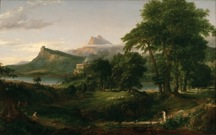
The house stands in a deer park laid out by ‘Capability’ Brown in the 18th century, with hills and woods.


| From Arcadia | ||
|---|---|---|
| reading Tom Stoppard | for insight. | |
|
||
| Derbyshire, England, UK. Chatsworth House Estate. The house stands in a deer park laid out by ‘Capability’ Brown in the 18th century, with hills and woods. |
||
| First | Second | Third | Fourth | Finish | ||
| Et in Arcadia Ego | ||
 |
 |
|
| Nicholas Poussin, "Les bergers d'Arcadie ," 1638-40. | Thomas Cole, Arcadia, 1858 | |
Select a passage from Arcadia as part of a scene to read to the class.
What does the language used mean?
Explain that to us with examples.
(where in the play does it occur in relation to other action, the background, the climax or the denouement?)
When writing recall that all literature should provide you three things to consider:
Do we sense in the selection any of the following themes?
What is Stoppard bringing together in Arcadia that informs us about science?
His science is infused with a discussion of landscape, desire and the recovery of lost knowledge.
This is largely because of something natural scientists call entropy. Now entropy is a measure of disorder in any transformation of energy from one state to another. A fire burning leaves behind the disorder of ashes, coals, and burnt carbon we call debris.
The term entropy implies that any kind of order is constantly lost over time. By order we mean structural order, the organization of facts into knowledge, or the production of sugar and oxygen by plants when they use water, carbon dioxide, and nutrients in photosynthesis.
He is using spacetime in the sense of general relativity to advance the events in the drama that reveal the loss and recovery of significant equations.
There is a "natural logic" to the world which humans frequently misunderstand, misinterpret, or knowingly misrepresent at their peril.

The tortoise (crawls across the table in the play) is older than the human who feeds her; her kind lives longer than does ours.
![]()
Bernard is a hungry academic, noisily self-centered man who doesn't care whom he insults or makes passes at.
Hannah Jarvis a best-selling author and landscape historian;
Valentine Coverly (brother of Chloe), an Oxford student of scientific mind, and
Chloe (Valentine's sister), two children of the present-day Lord and Lady Croom.
Ezra Chater (a hermit), discovered in the "hermitage" .
The more important players in the 1809 mystery are:
Septimus Hodge is a randy young man, part-time literary critic & the tutor of 13-year-old Thomasina Coverly
Thomasina Coverly a child prodigy who we meet at 13 and 17 years of age.
Lady Croom (Thomasina's mother), who has never put off a man who had the good taste to come on to her.
Richard Noakes (celebrated landscape architect based on the real person "Capability" Brown). Noakes is transforming Sidley Park's grounds from their comparatively natural look to a picturesque / romantic style.
There are at least two mysteries on which the comic narrative revolves as it introduces us to a set of dialectically opposite ideas.
A simply furnished room in a 19th century English manor. Septimus, 22, is grading at his desk, upstage left. Thomisina, 13, is working at the table that occupies the center of the room, papers spread around her. She looks up, facing the audience.
Thomisina: When you stir your rice pudding, Septimus, the spoonful of jam spreads itself round making red trails like the picture of a meteor in my astronomical atlas. (She turns upstage to him, fiercely.)
But if you stir backward, the jam will not come together again. Indeed, the pudding does not notice and continues to turn pink just as before. Do you think this is odd?
Septimus: No.
Thomisina: Well, I do. You cannot stir things apart.
Septimus slowly stands, gaining more and more conviction, a rare show of emotion in his dry, professorial demeanor.
Septimus: No more you can, time must needs run backward, and since it will not, we must stir our way onward mixing as we go, disorder out of disorder into disorder until pink is complete, unchanging and unchangeable, and we are done with it for ever. (Thomisina is in rapt attention, as Septimus stops himself.) This is known as free will or self-determination.
(He notices his pet tortoise has strayed to another part of his desk.)
Sit!
Thomisina: "Tell me more about sexual congress."
Using this play and the many examples from Joyce Carol Oates, begin writing a narrative that is either a theme or an examination of several authors and what they describe as defining qualities in environmental literature.
![]()
Themes in Environmental Literature
Essential parts of a narrative.